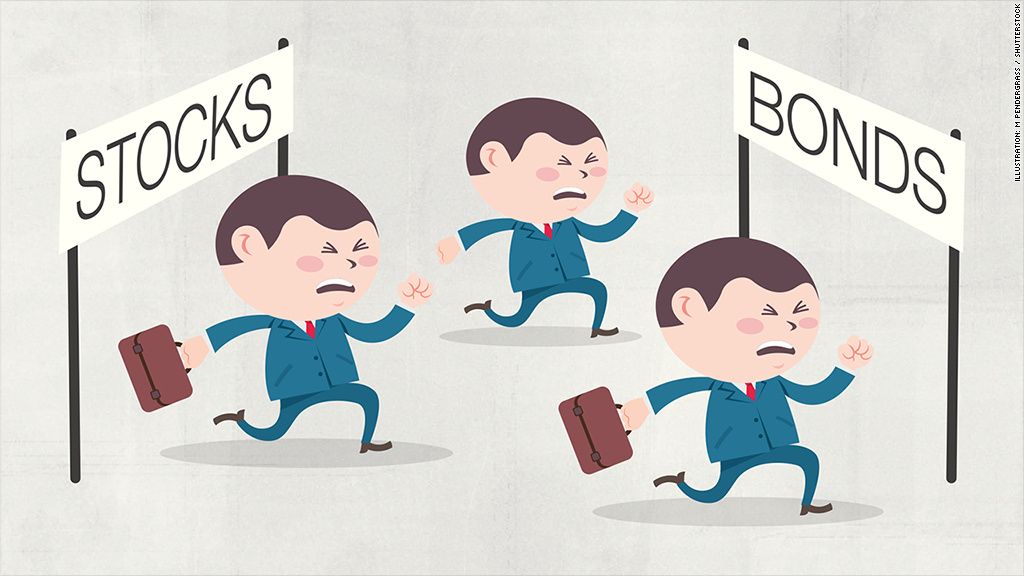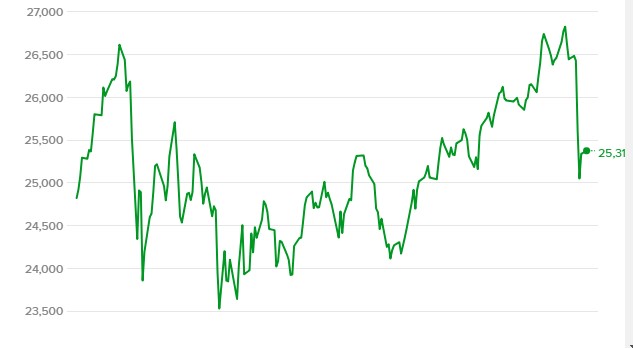- GOLD IRA
- Download Our 2024 Precious Metals IRA Investor’s Guide.
Click Here  Gold IRA
Gold IRA
 Investing
Investing
-
- CRYPTO IRA
- PRICES & STATS
- RETIREMENT PLANS
- BLOG
 Questions? Call (888) 820 1042
Questions? Call (888) 820 1042
Last Week’s Rare Stock Market Slaughter Slays Both Stocks and Bonds
Disclosure: Our content does not constitute financial advice. Speak to your financial advisor. We may earn money from companies reviewed. Learn more
Last Updated on: 22nd October 2018, 09:02 am

Stocks have been on a wild and volatile roller coaster ride since Wednesday a week ago. If you have paid attention to financial news, you can not help but notice that the fears of dramatically increasing interest rates on Wall Street have finally shaken the once-unshakable confidence of the long reigning stock market bulls. The initial drop was a shocking 800 points. Since this first massive decline, the Dow Jones Industrial Average has suffered several other 500 point drops over the course of this past week, occasionally bouncing back by several hundred points. This chart reveals the carnage in detail:

Losses in the DJIA were bad enough, but the percentage decline on Nasdaq proved to be worse. The index crashed a sobering four percent on the first day of the blood bath. Given that the environment created by central banks is now one of contraction and no longer expansion, it is not so reasonable at this point to assume that this is merely another long overdue correction in the ten year long bull market.
Now is the time to recognize that gold makes sense in an IRA. For the sake of both your investment and especially retirement portfolios, you need to start considering buying gold in monthly installments. As an added bonus, you are now able to keep your IRA gold in top offshore storage locations.
This Time, It Really Is Different…
In the past, when the stock market cratered like this in several single day equities market blowouts, investors would simply move their money over to U.S. Treasuries. This has generally been a reliable safe haven debt market where they could park their cash in the past. But not this time. The Wednesday, October 10th sharp drop in the equities occurred against a backdrop of other investors selling their so-called longer dated Treasuries.
This causes the yields (which move inversely to price) to rise. An unfortunate side effect of this is that interest rates then rise for all sorts of business and consumer (and government debt) loans. As Chief Investment Officer Peter Boockvar of Bleakley Advisory Group astutely put things:
“There's no flight to safety in bonds. That's a sea change.”
Now this is a worrying trend. According to analysts and market observers, it is a warning of future stock market selling to come. Until investors decide to trust the Treasuries again, they will likely remain in sell mode themselves. Ten year Treasuries took it the hardest that October 10th session.
They touched an intra-day high of 3.26 percent that first Wednesday. Only a month prior, the rate sat at under three percent, a huge difference in the world of American government debt. The 30 year bonds have seen their yields stay elevated. .They reached 3.37 percent and did not appreciably come back down in a recovery.
The rarity of the simultaneous stock and bond selloff has prompted some to research how frequently this phenomenon has actually occurred. CNBC employed Kensho to do a back tested analysis. In the last 20 years, almost any time the S&P 500 suffered a drop of over two percent in a month or less, then Treasuries would outperform in response.
In such cases, a top performing ETF to be invested in was TLT, the iShares 20+ Years Treasury ETF. As a tracking exchange traded fund for longer dated bonds, it managed to average 1.2 percent in gains in those months when the S&P declined by more than two percent. Yet this Wednesday, October 10th the TLT Treasury ETF was losing money for the day. The Head of U.S. Macro Strategies Larry McDonald of ACG Analytics explained this as:
“Something occurred in markets today that has been extremely rare this decade. In the past three years, there have only been 14 trading days (including today) where the S&P 500 was lower more than one percent and U.S. bonds (as in TLT) were also lower on the day. Stocks and bonds are wearing a very rare positive correlation.”
In other words, the long lasting correlation between rising stocks and bonds may now be a thing of the past, as they have effectively broken down with this latest series of events.
Stock Bond Selloff Threatens Other Serious Side Effects
As usual when the market suffers from an interest rate distortion, the likely culprit not far away from it is the Federal Reserve. Now the Fed is back to its old activity of raising interest rates in an effort to ‘normalize” them. This will continue to create market distortions (as have their activities of quantitative easing over the past 10 years).
With rates rising, bond yields are similarly increasing. This is pulling away money from equities. It creates a self fulfilling prophecy as investors realize that there are now more attractive rates to be had with fixed income and bond investments. By selling their stocks, they drive down prices and returns on stocks.
What is more serious is the effect that these rising rates are having on corporations who borrowed heavily in the near-zero interest rates of the last decade. Their stocks are suffering now, making the market selloff and volatility that much worse. Firms that operate best in environments where credit is cheap (like home building companies) are also suffering.
Head of Macro Strategies Peter Tchir of Academy Securities warned that in only four cases from the start of 2016 has the S&P dropped by at least 1.5 percent while bond yields have risen. Wednesday was one of these. The three other instances occurred when stocks suffered from extreme cases of volatility. It means analysts anticipate that a greater amount of volatility lies in the future. He explained this with:
“The first was January 13, 2016. That was when the Chinese repriced the renminbi overnight. Then the last two times were February 2 and February 8 of this year,” when stocks were highly volatile.
Bockvar warned that stocks became considerably more sensitive to bond yields as the 10 year Treasuries rose above 3.11 percent. This had been the last high. Now bond strategists and observers are expressing concern that the current rise in rates could top 3.5 percent before the end of 2018.
Who was the culprit of the latest run up in bond yields? No surprise, it turns out to be Federal Reserve Chairman Jerome Powell. It was in his now-infamous hawkish tone and language on October 3 that he discussed the Fed having rates that were far away from the neutral rate that started the bond yield run.
Gold Is Your Lifeline in This Sea Change of Investment Trouble
When analysts talk about a sea change in investing mentality, this is the time to sit ua\p and pay careful and close attention to the warning. What is happening now in both equities and bond markets is a warning of still more volatility and selling to come. The Federal Reserve is in a hurry to raise interest rates to the level they need in order to be able to react to a future recession. Unfortunately, by doing this, they are actually sowing the seeds for the next recession.
Gold is your best and most useful line of defense from this worst kind of self-fulfilling prophecy of the Federal Reserve. Now is the time to protect your retirement portfolio before the markets deteriorate any further and become still more volatile. It is a good idea to start reviewing Gold IRA allocation strategies and getting helpful information together on a Gold IRA rollover versus transfer. You should start reviewing the Gold IRA rules and regulations now. Next week could be too late.



 Silver
Silver Gold
Gold Platinum
Platinum Palladium
Palladium Bitcoin
Bitcoin Ethereum
Ethereum






